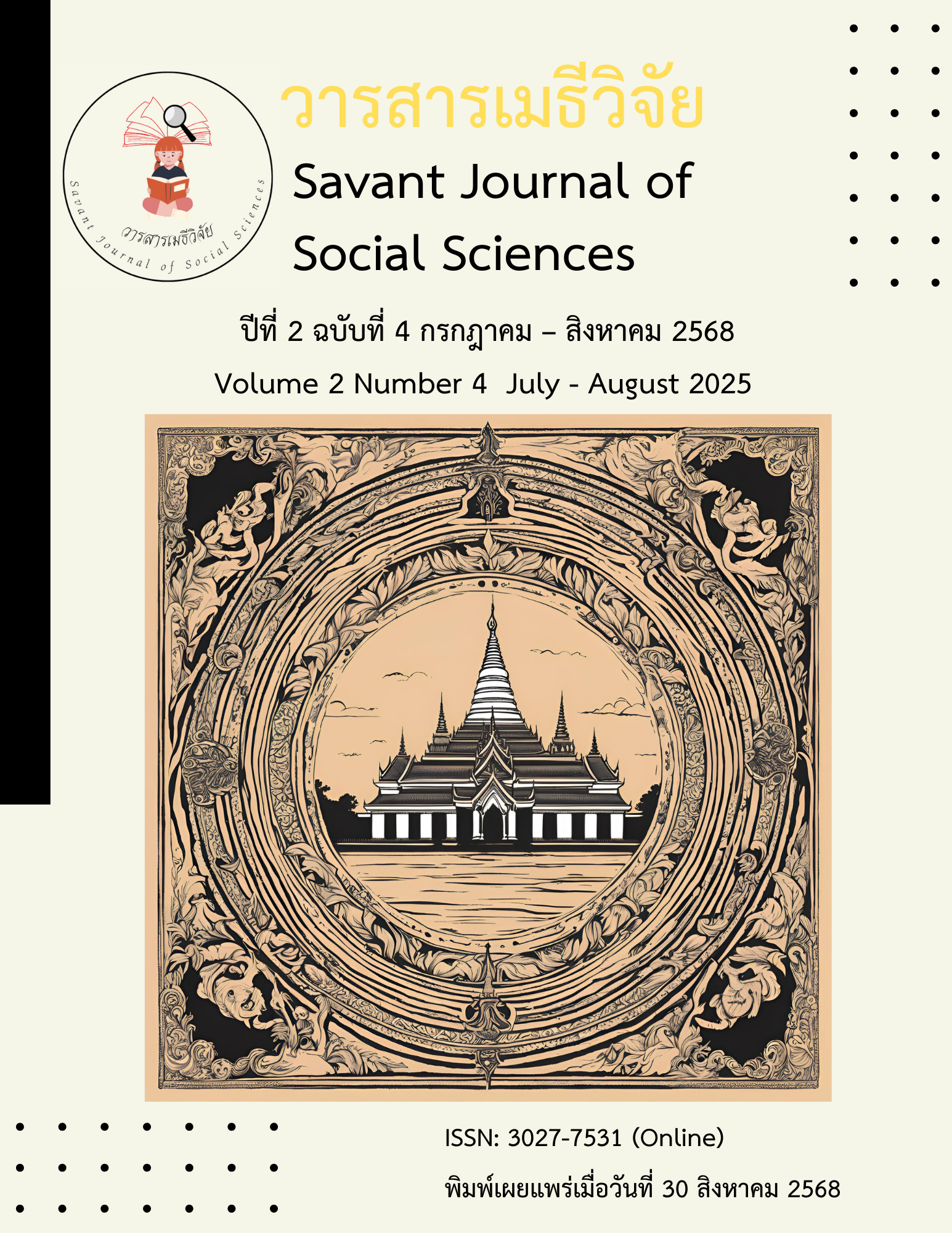The operating results of the Office of the National Anti-Corruption Commission Region 4 in promoting good governance in public sector under the STRONG-Sufficiency Economy Against Corruption Project
Keywords:
ธรรมาภิบาล; ผลการดำเนินงาน; คณะกรรมการป้องกันและปราบปรามการทุจริตแห่งชาติAbstract
The research article has objectives: 1) to study the performance of the Office of the National Anti-Corruption Commission Region 4 in promoting good governance in the public sector under the Strong-Sufficiency Economy Against Corruption Project; 2) to analyze the impact of the operation of the Office of the National Anti-Corruption Commission Region 4 in promoting good governance in the public sector under the Strong-Sufficiency Economy Against Corruption Project. This is quantitative research. Data was collected from a sample group of 72 people, using a questionnaire. Data were analyzed using frequency, percentage, mean, and standard deviation. The research results found that:
- Most of the respondents were male, accounting for 52.80 percent; aged between 20 and 30 years, accounting for 25.00 percent; and most were club members, accounting for 73.60 percent. They participated in the project. Strong-sufficiency mind against corruption in the period of 1-2 years, the most, accounting for 43.10 percent.
- The respondents have an overall opinion in all aspects at a high level, with an average of 3.73 and a standard deviation of 1.12. When considering each aspect, it was found that the aspect with the highest average was the aspect of awareness, with an opinion at a high level, an average of 3.91, and a standard deviation of 0.98, followed by the aspect of knowledge, with an opinion at a high level, an average of 3.89, and a standard deviation of 1.07, and the least was the aspect of compassion, with an opinion at a high level, an average of 3.55, and a standard deviation of 1.23.
References
จารุวรรณ สุขุมาพงษ์. (2556). แนวโน้มของคอรัปชั่นในประเทศไทย. สืบค้นเมื่อ 3 กรกฎาคม 2567, เข้าถึงได้จาก https://www.parliament.go.th/ewtadmin/ewt/elaw_parcy/ewt_dl_link.php?nid=1484
ธิฏิรัตน์ พิมลศรี, รภัสสรศ์ วงศ์ทองดี, นิติพล ธาระรูป, ณัฐวดี ลิ้มเลิศเจริญวนิช, ธนันต์ ไพรเกษตร. (2563). โครงการวิจัย การสังเคราะห์รูปแบบ กลไกและแนวทางการปลูกฝังเจตคติและวัฒนธรรมสุจริตเพื่อการป้องกันและปราบปรามการทุจริต. กรุงเทพฯ: สำนักงานคณะกรรมการป้องกันและปราบปรามการทุจริตแห่งชาติ.
นิภาพรรณ เจนสันติกุล. (2565). พหุเครือข่ายทางสังคมเพื่อการต่อต้านการทุจริตคอร์รัปชันในสังคมไทย: บทบาทและข้อเสนอเชิงนโยบายเพื่อการปฏิบัติ. วารสารสถาบันพระปกเกล้า, 20(1), 192-208.
ประเวศ วะสี. (2542). ยุทธศาสตร์ชาติ. กรุงเทพฯ: สำนักงานกองทุนเพื่อสังคมธนาคารออมสิน.
พีรพงษ์ แสงแก้ว และ กัมปนาท วงษ์วัฒนพงษ์. (2564). หลักธรรมาภิบาลกระบวนการบริหารจัดการภาครัฐแนวใหม่ภายใต้สถานการณ์โควิด 19. Journal of Roi Kaensarn Academi, 6(11), 303-316.
ภูดิศ นอขุนทด. (2565). หลักธรรมาภิบาลกับการบริหารงานภาครัฐ. Journal of MCU Ubon Review, 7(1), 1029-1044.
รินทร์ลภัส วุฒิปรีชาสิทธิ์. (2562). แนวทางการพัฒนาธรรมาภิบาลในการปฏิบัติงานของหน่วยงานภาครัฐ. วิทยานิพนธ์หลักสูตรรัฐประศาสนศาสตรมหาบัณฑิต สถาบันบัณฑิตพัฒนบริหาศาสตร์.
ศราวุฒิ ดาวกรองแก้ว, จีรพรรณ์ จันทร์วิเชียร, ธันยนันท์ จันทร์ทรงพล, บรรจง โซ๊ะมณี, ภาดา วงศ์อุไร. (2563). การใช้หลักธรรมาภิบาลในการบริหารงานสำนักงานเขตประเวศ กรุงเทพมหานคร. วารสารรัชต์ภาคย์, 15 (40), 147-159.
ศิรประภา พัดลม. (2564). การนำหลักธรรมาภิบาลไปใช้ในการบริหารจัดการขององค์การบริหารส่วนตำบลห้วยหิน อำเภอชัยบาดาล จังหวัดลพบุรี. การค้นคว้าอิสระหลักสูตรรัฐประศาสนศาสตรมหาบัณฑิต สาขาวิชารัฐประศาสนศาสตร์ มหาวิทยาลัยราชภัฏเทพสตรี.
ละเอียด ศิลาน้อย. (2560). การใช้สูตรทางสถิติ (ที่ถูกต้อง) ในการกำหนดขนาดของกลุ่มตัวอย่างเพื่อการวิจัยเชิงปริมาณในทางมนุษยศาสตร์และสังคมศาสตร์. วารสารวิจัยและพัฒนา มหาวิทยาลัยราชภัฏบุรีรัมย์, 12 (2), 50-61.
วรภัทร โตธนะเกษม. (2542). การสร้าง Good Governance ในองค์กร. วารสาร กสท, 5(4), 11-17.
วรธา มงคลสืบสกุล. (2567). แนวทางการป้องกันการทุจริตเชิงรุก โอกาส และความท้าทายของสังคมไทย. วารสารวิชาการ ป.ป.ช, 17(1), 2-16.
สำนักงานคณะกรรมการป้องกันและปราบปรามการทุจริตแห่งชาติ. (2561) ประวัติและความเป็นมา. สืบค้นเมื่อ 14 กรกฎาคม 2567, เข้าถึงได้จาก https://www.nacc.go.th/categorydetail/2019112416310492/20191124163234
สำนักงานคณะกรรมการป้องกันและปราบปรามการทุจริตแห่งชาติ. (2561). ความหมายของตราสัญลักษณ์. สืบค้นเมื่อ 14 กรกฎาคม 2567, เข้าถึงได้จากhttps://www.nacc.go.th/categorydetail/20190117143842148/20191124163415?
สำนักงานคณะกรรมการป้องกันและปราบปรามการทุจริตแห่งชาติ. (2567). ป.ป.ช. เผยองค์กรเพื่อความโปร่งใสนานาชาติประกาศผลดัชนีการรับรู้การทุจริต (CPI) ประจำปี 2566 ประเทศไทย ได้ 35 คะแนน จัดอยู่ในอันดับที่ 108 -ของโลก. สืบค้นเมื่อ 7 กรกฎาคม 2567, เข้าถึงได้จากhttps://www.nacc.go.th/categorydetail/2018083118464105/20240130143633?
อริศรา เล็กสรรเสริญ, สุริยน วงศ์สุจริต, ศิรินันท์ วัฒนศิริธรรม และพรสวรรค์ ประเทสัง. (ม.ป.ป.). การมีส่วนร่วมของภาคประชาชนในการดำเนินงานด้านการป้องกันการทุจริตกับสำนักงาน ป.ป.ช.. สืบค้นเมื่อ 3 กรกฎาคม 2567, เข้าถึงได้จาก https://www.nacc.go.th/uploads/files114740928/journal1509/..pdf






